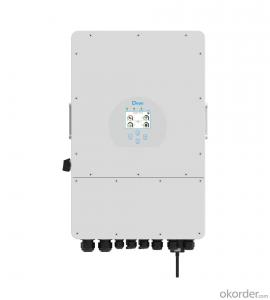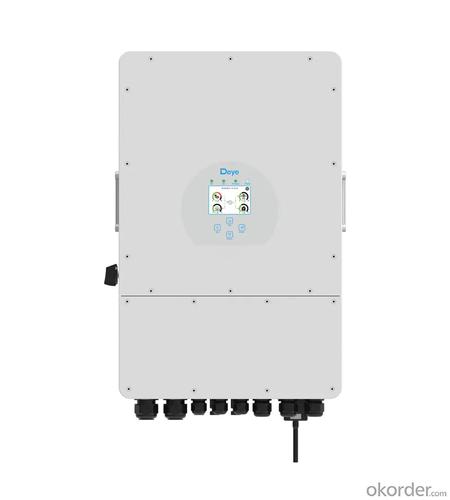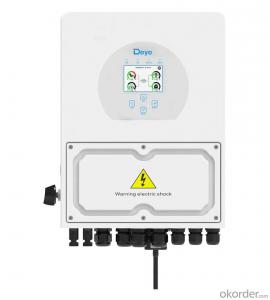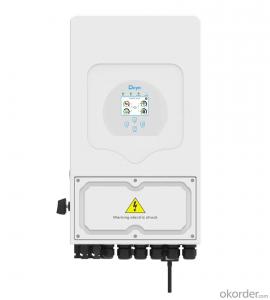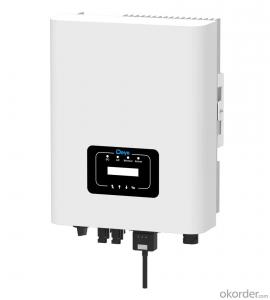Nep Solar Inverter - Sun-5/6/8/10/12k-SG04LP3 Hybrid Inverter Low Voltage Battery Higher Yields
- Loading Port:
- Ningbo
- Payment Terms:
- TT OR LC
- Min Order Qty:
- 100 pc
- Supply Capability:
- 5000 pc/month
OKorder Service Pledge
OKorder Financial Service
You Might Also Like
Specification
Higher yields / Safe & Reliable / Smart / User-friendly
SUN 5/6/8/10/12K-SG is brand new three phase hybrid inverter with low battery voltage 48V, ensuring system safe and reliable. With compact design and high-power density, this series supports 1.3 DC/AC ratio, saving device investment. It supports three phase unbalanced output, extending the application scenarios. Equipped with CAN port (x2) BMS and parallel, x1 RS485 port for BMS, x1 RS232 port for remotely control, x1 DRM port, which makes the system smart and flexible.
100% unbalanced output, each phase; Max. output up to 50% rated power
DC couple and AC couple to retrofifit existing solar system
Max. 16pcs parallel for on-grid and offff-grid operation; Support multiple batteries parallel
Max. charging/discharging current of 240A
48V low voltage battery, transformer isolation design
6 time periods for battery charging/discharging
Support storing energy from diesel generator
| Technical Data | |||||||
| Model | SUN-5K -SG04LP3-EU | SUN-6K -SG04LP3-EU | SUN-8K -SG04LP3-EU | SUN-10K -SG04LP3-EU | SUN-12K -SG04LP3-EU | ||
| Battery Input Data | |||||||
| Battery Type | Lead-acid or Li-lon | ||||||
| Battery Voltage Range (V) | 40~60 | ||||||
| Max. Charging Current (A) | 120 | 150 | 190 | 210 | 240 | ||
| Max. Discharging Current (A) | 120 | 150 | 190 | 210 | 240 | ||
| External Temperature Sensor | Yes | ||||||
| Charging Curve | 3 Stages / Equalization | ||||||
| Charging Strategy for Li-Ion Battery | Self-adaption to BMS | ||||||
| PV String Input Data | |||||||
| Max. DC Input Power (W) | 6500 | 7800 | 10400 | 13000 | 15600 | ||
| Rated PV Input Voltage (V) | 550 (160~800) | ||||||
| Start-up Voltage (V) | 160 | ||||||
| MPPT Voltage Range (V) | 200-650 | ||||||
| Full Load DC Voltage Range (V) | 350-650 | ||||||
| PV Input Current (A) | 13+13 | 26+13 | |||||
| Max. PV ISC (A) | 17+17 | 34+17 | |||||
| Number of MPPT / Strings per MPPT | 2/1+1 | 2/2+1 | |||||
| AC Output Data | |||||||
| Rated AC Output and UPS Power (W) | 5000 | 6000 | 8000 | 10000 | 12000 | ||
| Max. AC Output Power (W) | 5500 | 6600 | 8800 | 11000 | 13200 | ||
| AC Output Rated Current (A) | 7.6 | 9.1 | 12.1 | 15.2 | 18.2 | ||
| Max. AC Current (A) | 11.4 | 13.6 | 18.2 | 22.7 | 27.3 | ||
| Max. Continuous AC Passthrough (A) | 45 | ||||||
| Peak Power (off grid) | 2 time of rated power, 10 S | ||||||
| Power Factor | 0.8 leading to 0.8 lagging | ||||||
| Output Frequency and Voltage | 50/60Hz; 3L/N/PE 220/380, 230/400Vac | ||||||
| Grid Type | Three Phase | ||||||
| DC injection current (mA) | THD<3% (Linear load<1.5%)< td=""> | ||||||
| Efficiency | |||||||
| Max. Efficiency | 97.60% | ||||||
| Euro Efficiency | 97.00% | ||||||
| MPPT Efficiency | 99.90% | ||||||
| Integrated | PV Input Lightning Protection, Anti-islanding Protection, PV String Input Reverse Polarity Protection, Insulation Resistor Detection, Residual Current Monitoring Unit, Output Over Current Protection, Output Shorted Protection, Surge protection | ||||||
| Output Over Voltage Protection | DC Type II/AC Type III | ||||||
| Certifications and Standards | |||||||
| Grid Regulation | CEI 0-21, VDE-AR-N 4105, NRS 097, IEC 62116, IEC 61727, G99, G98, VDE 0126-1-1, RD 1699, C10-11 | ||||||
| Safety EMC / Standard | IEC/EN 61000-6-1/2/3/4, IEC/EN 62109-1, IEC/EN 62109-2 | ||||||
| General Data | |||||||
| Operating Temperature Range (℃) | -45~60℃, >45℃ derating | ||||||
| Cooling | Smrat cooling | ||||||
| Noise (dB) | <45 dB | ||||||
| Communication with BMS | RS485; CAN | ||||||
| Weight (kg) | 33.6 | ||||||
| Size (mm) | 422W x 699.3H x279D IP65 | ||||||
| Protection Degree | IP65 | ||||||
| Installation Style | Wall-mounted | ||||||
| Warranty | 5 years | ||||||
- Q: Can a solar inverter be used in grid-tied systems?
- Yes, a solar inverter can be used in grid-tied systems. In fact, a grid-tied system requires a solar inverter to convert the DC power generated by the solar panels into AC power that can be fed into the electrical grid. The solar inverter also ensures that the system synchronizes with the grid and complies with safety regulations.
- Q: How does a solar inverter ensure safety during maintenance?
- A solar inverter ensures safety during maintenance by incorporating various safety features such as automatic shut-off mechanisms, grounding protection, and isolation of high-voltage components. Additionally, it may have user-friendly interfaces and clear warning labels to guide technicians while working on the equipment. These measures help prevent electrical hazards and ensure the safety of maintenance personnel.
- Q: What is the role of a solar inverter in a residential system?
- The role of a solar inverter in a residential system is to convert the direct current (DC) electricity produced by the solar panels into alternating current (AC) electricity that can be used to power household appliances and be fed into the electrical grid. It ensures efficient use of solar energy and enables easy integration of solar power into the existing electrical infrastructure of a home.
- Q: How does a solar inverter handle variations in solar panel cleanliness?
- A solar inverter does not directly handle variations in solar panel cleanliness. However, a decrease in solar panel cleanliness can lead to a decrease in the overall energy output of the solar system. This reduced energy input is then processed by the solar inverter, which converts it into usable electricity. Therefore, while a solar inverter itself does not handle the cleanliness of solar panels, it indirectly adapts to variations by adjusting the energy conversion process based on the input it receives from the panels.
- Q: How do you calculate the power loss in a solar inverter?
- To calculate the power loss in a solar inverter, you need to subtract the output power from the input power. The input power can be determined by multiplying the input voltage and input current, while the output power is obtained by multiplying the output voltage and output current. Subtracting the output power from the input power will give you the power loss in the solar inverter.
- Q: Can a solar inverter be used with a solar-powered telecommunications system?
- Yes, a solar inverter can be used with a solar-powered telecommunications system. A solar inverter is an essential component of a solar-powered system as it converts the direct current (DC) generated by solar panels into alternating current (AC) that can be used to power various electrical devices, including telecommunications equipment. By using a solar inverter, the solar-generated electricity can be efficiently utilized to run a telecommunications system, making it a sustainable and environmentally-friendly solution.
- Q: How do you choose the right brand of solar inverter?
- When choosing the right brand of solar inverter, several factors should be considered. First, look for a brand with a good reputation and a track record of reliability. It's important to choose a brand that has been in the market for some time and has positive customer reviews. Additionally, consider the warranty and after-sales service provided by the brand. Look for a brand that offers a comprehensive warranty and has a strong customer support system in place. Finally, consider the specific requirements and features you need from the inverter, such as its power output, efficiency, and compatibility with your solar system. Comparing different brands based on these factors will help you make an informed decision and choose the right brand of solar inverter for your needs.
- Q: What is the maximum efficiency rating of a solar inverter?
- The maximum efficiency rating of a solar inverter can vary, but typically it ranges between 95% and 98%.
- Q: What are the potential risks of fire or explosions from a faulty solar inverter?
- The potential risks of fire or explosions from a faulty solar inverter include electrical malfunctions leading to overheating, short circuits, and voltage surges. These issues can cause fires or explosions if not addressed promptly, posing a threat to property and potentially endangering lives. It is crucial to regularly inspect and maintain solar inverters to mitigate these risks and ensure safe operation.
- Q: Are there any maintenance requirements for a solar inverter?
- Yes, solar inverters do have maintenance requirements. Regular cleaning of the solar inverter and its components is necessary to remove dust and debris. Additionally, checking for loose connections, inspecting for any physical damage, and ensuring proper ventilation are important maintenance tasks. It is also recommended to monitor the inverter's performance regularly and promptly address any issues or errors that may arise.
Send your message to us
Nep Solar Inverter - Sun-5/6/8/10/12k-SG04LP3 Hybrid Inverter Low Voltage Battery Higher Yields
- Loading Port:
- Ningbo
- Payment Terms:
- TT OR LC
- Min Order Qty:
- 100 pc
- Supply Capability:
- 5000 pc/month
OKorder Service Pledge
OKorder Financial Service
Similar products
Hot products
Hot Searches
Related keywords
